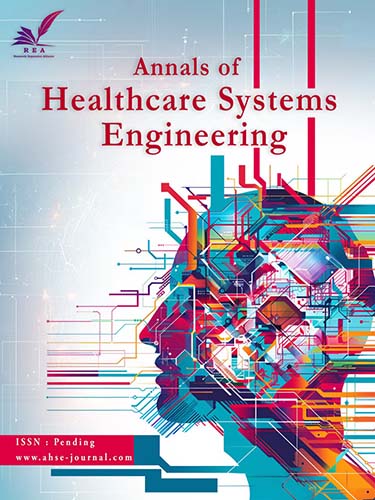AI-driven IoT Solutions for Managing Healthcare Data in Smart Cities
Abstract
The integration of Artificial Intelligence (AI) and the Internet of Things (IoTs) in the healthcare sector has opened up new possibilities for improving health services within innovative urban settings. This article provides a comprehensive overview of AI-IoTs systems aimed at managing healthcare data in smart cities. Key components such as predictive health analytics, remote patient monitoring, and the interoperability of healthcare systems are explored. The impact of these technologies on the management of chronic illnesses, telemedicine, and smart city infrastructure will be analyzed, considering important aspects related to privacy and ethical concerns. Our findings suggest that AI-IoTs systems hold the promise of improving real-time patient monitoring and AI-driven diagnostic capabilities, thereby significantly transforming the healthcare landscape.
Keywords:
Artificial intelligence, Internet of things, healthcare, Smart cities, Data privacyReferences
- [1] Li, C., Wang, J., Wang, S., & Zhang, Y. (2024). A review of IoT applications in healthcare. Neurocomputing, 565, 127017. https://doi.org/10.1016/j.neucom.2023.127017
- [2] Stafie, C. S., Sufaru, I. G., Ghiciuc, C. M., Stafie, I. I., Sufaru, E. C., Solomon, S. M., & Hancianu, M. (2023). Exploring the intersection of artificial intelligence and clinical healthcare: A multidisciplinary review. Diagnostics, 13(12), 1995. https://doi.org/10.3390/diagnostics13121995
- [3] Maleki Varnosfaderani, S., & Forouzanfar, M. (2024). The role of AI in hospitals and clinics: transforming healthcare in the 21st century. Bioengineering, 11(4), 337. https://doi.org/10.3390/bioengineering11040337
- [4] Hosny, A., Parmar, C., Quackenbush, J., Schwartz, L. H., & Aerts, H. J. W. L. (2018). Artificial intelligence in radiology. Nature reviews cancer, 18(8), 500–510. https://doi.org/10.1038/s41568-018-0016-5
- [5] Haseltine, W. A. (2024). Medical artificial intelligence: A new frontier in precision medicine. Inside precision medicine, 11(1), 46–49. https://doi.org/10.1089/ipm.11.01.10
- [6] Shah, D., Dixit, R., Shah, A., Shah, P., & Shah, M. (2020). A comprehensive analysis regarding several breakthroughs based on computer intelligence targeting various syndromes. Augmented human research, 5(1), 14. https://doi.org/10.1007/s41133-020-00033-z
- [7] Rashid, A. (2024). Internet of Things (IoT) its applications and enabling technologies in healthcare: A review. Educational administration: theory and practice, 30(4), 9699–9714. https://doi.org/10.53555/kuey.v30i4.5031
- [8] Yenurkar, G., Mal, S., Nyangaresi, V. O., Kamble, S., Damahe, L., & Bankar, N. (2024). Revolutionizing chronic heart disease management: the role of IoT-based ambulatory blood pressure monitoring system. Diagnostics, 14(12), 1297. https://doi.org/10.3390/diagnostics14121297
- [9] Agali, K., Masrom, M., Abdul Rahim, F., & Yahya, Y. (2024). IoT-based remote monitoring system: A new era for patient engagement. Healthcare technology letters, 11(6), 437–446. https://doi.org/10.1049/htl2.12089
- [10] Edayan, J. M., Gallemit, A. J., Sacala, N. E., Palmer, X. L., Potter, L., Rarugal, J., & Velasco, L. C. (2024). Integration technologies in laboratory information systems: A systematic review. Informatics in medicine unlocked, 50, 101566. https://doi.org/10.1016/j.imu.2024.101566
- [11] Shojaei, P., Vlahu-Gjorgievska, E., & Chow, Y. W. (2024). Security and privacy of technologies in health information systems: A systematic literature review. Computers, 13(2), 41. https://doi.org/10.3390/computers13020041
- [12] Said, A., Yahyaoui, A., & Abdellatif, T. (2023). HIPAA and GDPR compliance in IoT healthcare systems. International conference on model and data engineering (pp. 198–209). Springer, Cham. https://doi.org/10.1007/978-3-031-55729-3_16
- [13] Owen, J., Favour, O., & Barnty, B. (2024). Smart healthcare: leveraging IoT for real-time patient monitoring and predictive analytics. https://B2n.ir/g87009
- [14] Kistkins, S., Mihailovs, T., Lobanovs, S., Pīrāgs, V., Sourij, H., Moser, O., & Bļizņuks, D. (2023). Comparative analysis of predictive interstitial glucose level classification models. Sensors, 23(19), 8269. https://doi.org/10.3390/s23198269
- [15] Gentile, F., & Malara, N. (2024). Artificial intelligence for cancer screening and surveillance. ESMO real world data and digital oncology, 5, 100046. https://doi.org/10.1016/j.esmorw.2024.100046
- [16] Sun, X., Yin, Y., Yang, Q., & Huo, T. (2023). Artificial intelligence in cardiovascular diseases: diagnostic and therapeutic perspectives. European journal of medical research, 28(1), 242. https://doi.org/10.1186/s40001-023-01065-y
- [17] Rancea, A., Anghel, I., & Cioara, T. (2024). Edge computing in healthcare: innovations, opportunities, and challenges. Future internet, 16(9), 329. https://doi.org/10.3390/fi16090329
- [18] Haleem, A., Javaid, M., Singh, R. P., & Suman, R. (2021). Telemedicine for healthcare: capabilities, features, barriers, and applications. Sensors international, 2, 100117. https://doi.org/10.1016/j.sintl.2021.100117
- [19] Vorisek, C. N., Lehne, M., Klopfenstein, S. A. I., Mayer, P. J., Bartschke, A., Haese, T., & Thun, S. (2022). Fast Healthcare Interoperability Resources (FHIR) for interoperability in health research: systematic review. JMIR medical informatics, 10(7), e35724. https://doi.org/10.2196/35724




